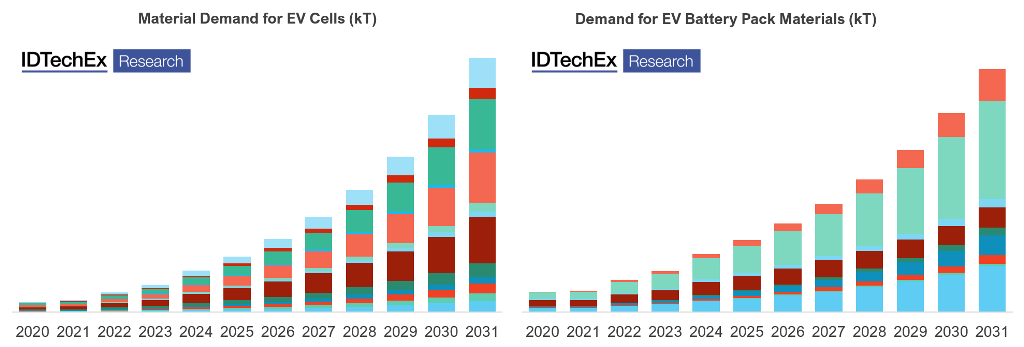Unexpected Trends From IDTechEx’s EV Data & Tools Portfolio
2021 is cementing the electric car’s dominant position in the auto industry’s future as OEMs have increased electrification targets, announced more battery-electric models, and planned new technology adoption strategies. To properly understand these trends, granular, high-quality data is essential.
IDTechEx’s portfolio of electric cars and powertrain materials research is driven by data and includes two new spreadsheet-based products: “Electric Car Sales, Models & Technologies Database” and “Scenario Forecasting: Materials for Battery Cells and Packs”. Both underpin two IDTechEx research reports, “Advanced Electric Cars 2020-2040” and “Materials for Electric Vehicle Battery Cells and Packs 2021-2031”, and form part of a more comprehensive portfolio, which can be found at www.IDTechEx.com/data.
IDTechEx’s New Electric Vehicle Model Database
IDTechEx’s extensive “Electric Car Sales, Models & Technologies Database” is spreadsheet-based and covers unit sales for popular BEV and PHEV cars in China, Europe, and the US between 2015–2020 (containing data on 145 distinct models plus variants). Alongside sales data, IDTechEx also reveals battery capacity, cell format, battery supplier, cell chemistry, cell and pack energy density, thermal management method, motor technology and power output. The granular nature of the data, split by model, enables technology trends to be analyzed in detail in addition to an industry-level overview.
Considering battery chemistry, it is well known that manufacturers have been trending towards higher nickel content cathodes, such as the 811 variant of nickel manganese cobalt oxide (NMC). Perhaps less expected is the significant resurgence in lithium-iron-phosphate, or ‘LFP’, batteries. The lower energy density of LFP batteries saw them fall out of favour with Chinese policymakers and rapidly lose market share up to 2019, but in the past year, BYD announced the Blade with LFP prismatic cells, and Tesla introduced the Chinese manufactured Model 3 with LFP. The trade-off comes down to price, raw materials, safety, and supply-chain dynamics with regional specificities.
Moreover, the Electric Car Sales, Models & Technologies Database also looks at electric traction motor trends. Many have voiced concerns around the supply of rare piles of the earth for the magnetic materials used in most electric car traction motors. However, China controls most of the world’s rare earth supply chain, creating risk and potential price volatility. The database reveals the slow adoption of non-permanent magnet-based variants – induction motors and separately excited wound-rotor motors – which are still being introduced in new models and may become essential technologies if permanent magnet prices spike.
This database underpins IDTechEx’s research on Advanced Electric Cars, which is further summarized in a report covering regional detail, powertrain technologies, and autonomous vehicles (www.IDTechEx.com/car).
Materials for Electric Car Battery Cells & Packs
Lithium-ion batteries in electric vehicles present very different material demands at the cell- and pack-level compared with the internal combustion engine (ICE) vehicles they replace. Whilst ICE drivetrains heavily rely on aluminium and steel alloys, Li-ion batteries also utilize many other materials such as nickel, cobalt, lithium, copper, insulation, thermal interface materials, and much more at a cell- and pack level. The IDTechEx report on “Materials for Electric Vehicle Battery Cells and Packs 2021-2031” identifies and analyzes trends in the design of EV battery cells and battery packs to evaluate the materials used for their assembly and production. The report also provides granular market forecasts for over 20 key material categories in terms of demand in tonnes in addition to market value.
To complement this research, IDTechEx’s new “Scenario Forecasting Spreadsheet: Materials for Electric Vehicle Battery Cells and Packs” provides quantitative forecasts and assumptions in greater depth and allows EV forecasts to be customized based on different scenarios. This is a spreadsheet-based tool that lists IDTechEx’s assumptions for several material intensities at a cell- and pack-level for BEV and PHEV batteries in the car market. It also provides a forecast for the multi-metal, and other materials demand in tonnes from 2021-2031. In addition to these forecasts, this tool allows you to use your projections for BEV and PHEV unit sales and battery capacities to see how these variables impact demand over the next ten years. A scenarios tool is also included, allowing several sales forecasts to be compared simultaneously for individual materials.
NEXT UP IN NEWS
- A New Database for Electric Car Sales, Models and Technologies from IDTechEx
- Canada To Ban ICE Vehicles, Despite the Negative Effects of Cold Weather on Batteries
- Monte Carlo Model Adds Fizz to ŠKODA Fabia Range
- 2022 Cadillac CT4-V Blackwing Leverages Latest Aero-Development Technology to Optimize Performance
- 2022 Buick Enclave Enhances Brand’s Premium SUV Lineup With Sharper Designs and More Driver-Assistance Technologies




Comments are closed.